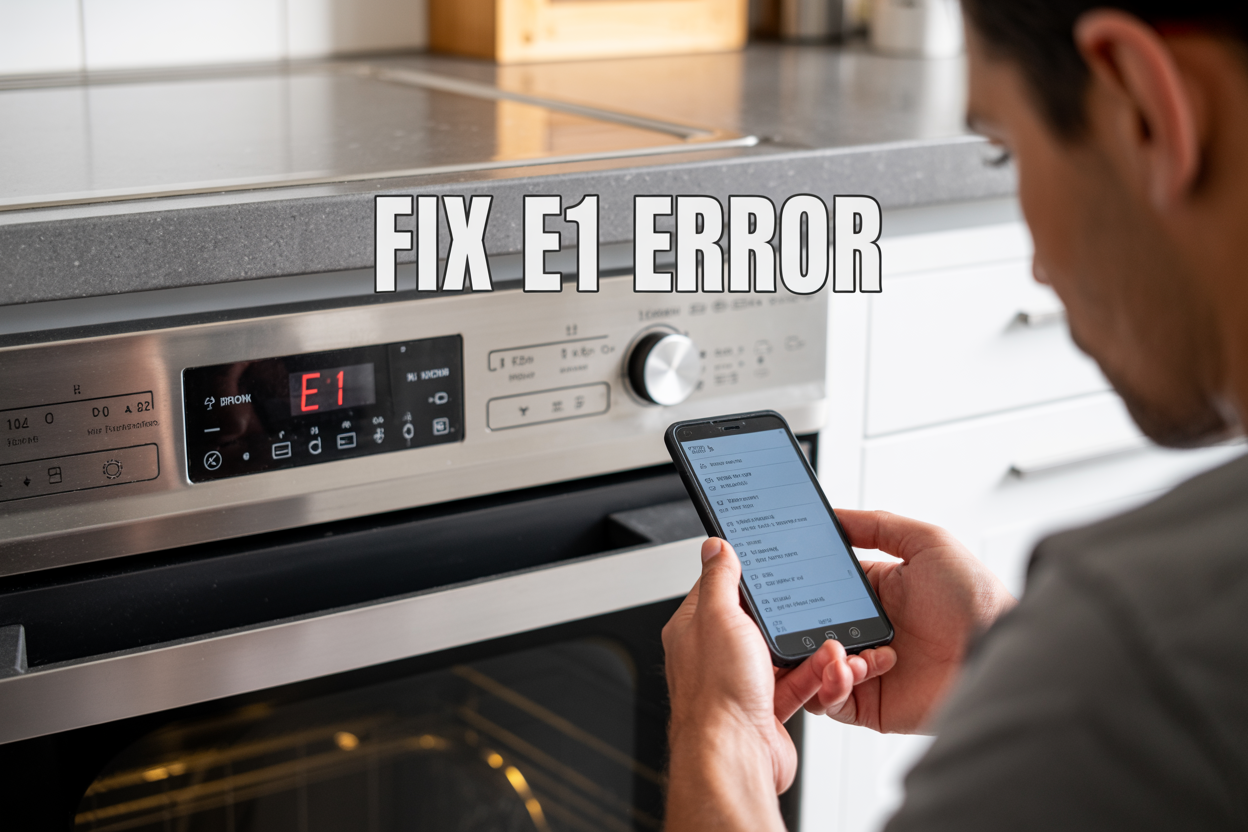
Your dishwasher suddenly stops mid-cycle and displays an E1 error code, leaving you with dirty dishes and a pile of frustration. This common dishwasher E1 error typically signals water supply issues, drainage problems, or sensor malfunctions that prevent your appliance from running properly.
This guide is designed for homeowners who want to fix their dishwasher without calling a repair technician right away. You’ll learn what the dishwasher E1 error meaning actually is and discover practical solutions that can save you time and money.
We’ll walk you through quick DIY troubleshooting steps you can try in the next few minutes, including checking your water supply, cleaning filters, and inspecting the door gasket. You’ll also get step-by-step repair solutions for common culprits like clogged drain pumps, faulty float switches, and blocked water inlet hoses. Finally, we’ll cover when it makes sense to call a professional and how to prevent this annoying error from happening again.
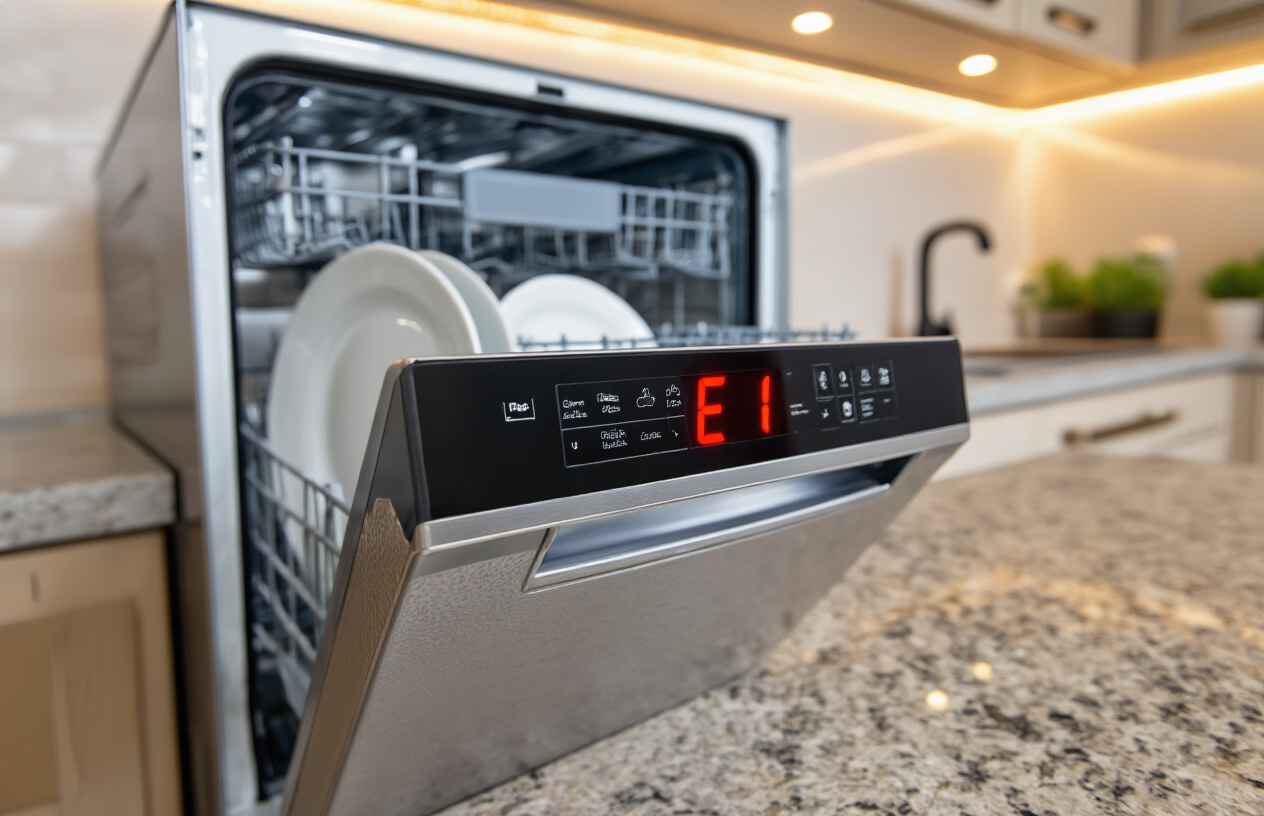
The E1 error code on your dishwasher is essentially your appliance’s way of telling you there’s a problem with water supply or drainage. When this error appears on your display panel, it signals that the dishwasher’s internal sensors have detected an issue preventing proper water flow during the wash cycle.
Most commonly, the dishwasher E1 error meaning points to water-related malfunctions, including insufficient water filling, drainage blockages, or leaks within the system. The error acts as a protective mechanism, stopping the wash cycle to prevent potential damage to your dishwasher’s internal components or flooding in your kitchen.
When your dishwasher displays an E1 error, it might also indicate problems with the water inlet valve, clogged filters, or issues with the drain pump. The specific meaning can vary slightly between manufacturers, but water supply problems remain the primary culprit across different brands.
Several major dishwasher manufacturers use the E1 error code system, though each brand may have slight variations in what triggers this specific code:
| Brand | E1 Error Focus |
|---|---|
| Bosch | Water supply/drainage issues |
| Siemens | Leak detection and water flow |
| Miele | Water inlet problems |
| Electrolux | Drain pump and filter blockages |
| Whirlpool | Water level sensor malfunctions |
| Kenmore | General water supply errors |
Bosch and Siemens dishwashers are particularly known for displaying E1 errors related to dishwasher water supply error conditions. These brands have sensitive leak detection systems that trigger the E1 code when moisture is detected in areas where it shouldn’t be.
European brands like Miele and AEG also commonly show E1 errors, often related to water inlet valve problems or dishwasher E1 error low water pressure situations. Understanding your specific brand helps narrow down the troubleshooting approach.
E1 errors typically manifest during specific phases of your dishwasher’s operation, and understanding when they occur helps identify the root cause. The error most commonly appears during the initial fill phase when your dishwasher attempts to draw water from your home’s supply lines.
Dishwasher E1 error leak detection happens when internal sensors identify water where it shouldn’t be – often in the base pan beneath the dishwasher tub. This triggers an immediate safety shutdown to prevent water damage to your flooring and cabinetry.
Low water pressure situations cause E1 errors because modern dishwashers expect consistent water flow rates. When pressure drops below optimal levels, the appliance can’t fill properly within its programmed timeframe, triggering the error code.
Clogged components also play a major role in E1 error occurrences. When filters become blocked with food debris or the dishwasher E1 error drain pump can’t function properly due to obstructions, water backs up and triggers the error system.
The dishwasher E1 error float switch is another common trigger point. This small device monitors water levels inside the dishwasher tub. If it gets stuck or malfunctions, it sends incorrect signals to the control board, resulting in an E1 error even when water levels are actually normal.
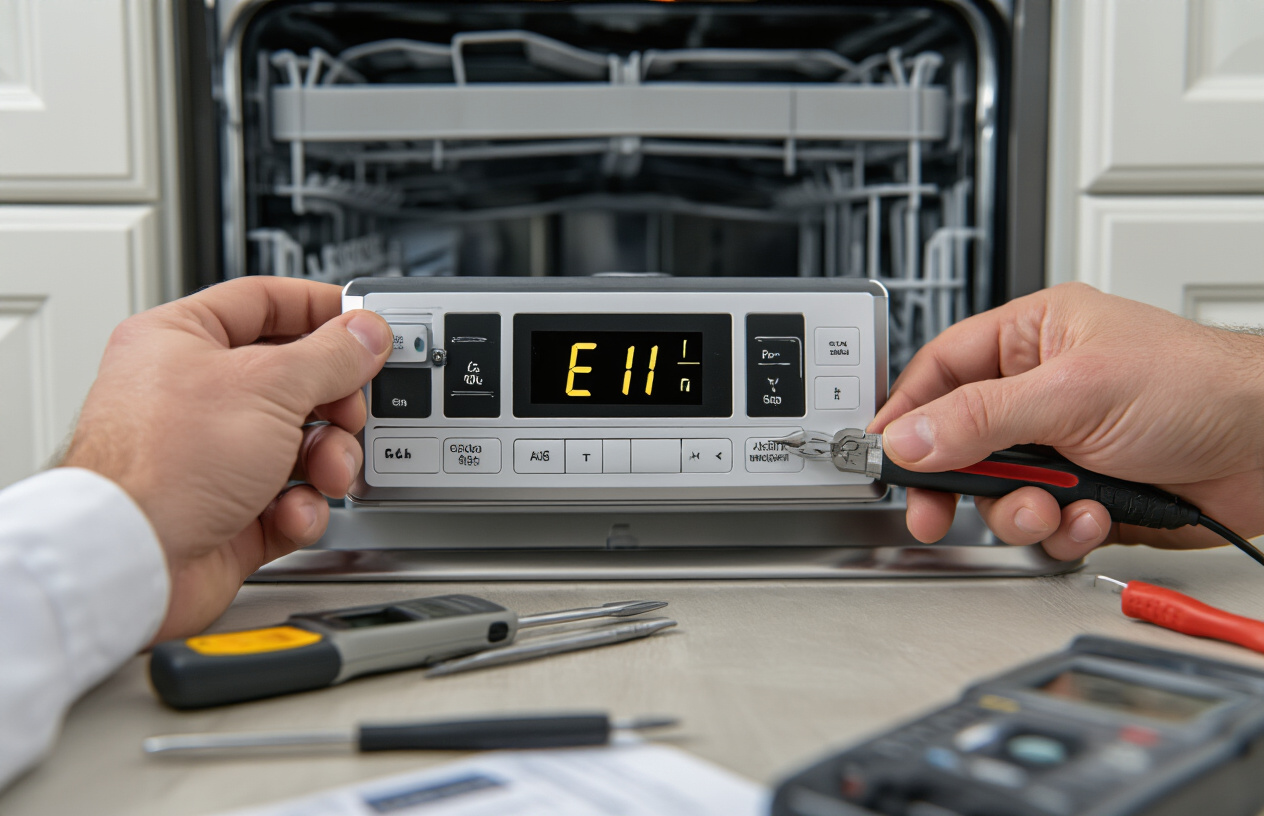
dishwasher E1 error low water pressure problems rank among the most frequent culprits behind this frustrating error code. Your dishwasher needs adequate water pressure to function properly, typically requiring between 20-120 PSI to operate effectively. When water pressure drops below the minimum threshold, the dishwasher’s sensors detect insufficient flow and trigger the E1 error as a protective measure.
Check your home’s water pressure by turning on nearby faucets while the dishwasher attempts to fill. If water flow seems weak throughout your home, contact your water utility company or consider installing a pressure booster system. Sometimes the issue stems from partially closed shut-off valves under your kitchen sink – ensure these valves are fully open.
dishwasher water supply error can also result from kinked or damaged water supply lines. Inspect the braided stainless steel or plastic supply hose connecting your dishwasher to the household water system. Look for bends, crimps, or visible damage that could restrict water flow.
dishwasher E1 error cleaning filters becomes necessary when accumulated food debris and grease block proper water circulation. Most dishwashers feature cylindrical or mesh filters located at the bottom of the tub, typically beneath the lower spray arm. These filters trap food particles but require regular maintenance to prevent clogs.
Remove the bottom dish rack and locate the filter assembly. Unscrew the cylindrical filter (usually requiring a quarter-turn counterclockwise) and lift out the mesh filter beneath it. Rinse both components under hot running water, using a soft brush to remove stubborn debris. Avoid using harsh chemicals or abrasive materials that could damage the filter mesh.
Drainage issues often accompany filter problems. Check your garbage disposal if your dishwasher drains into it – run the disposal to clear any blockages. Inspect the drain hose where it connects to your sink’s plumbing for kinks or clogs that could prevent proper drainage.
The water inlet valve controls water flow into your dishwasher and can fail mechanically or electrically. dishwasher E1 error water inlet hose problems often indicate valve-related issues. This solenoid-operated valve opens and closes based on signals from the control board, allowing water to enter during fill cycles.
Signs of inlet valve failure include unusual clicking sounds during fill attempts, no water entering the dishwasher despite proper supply pressure, or water continuously flowing even when the dishwasher is off. The valve contains internal screens that can become clogged with sediment, particularly in areas with hard water.
Testing the inlet valve requires a multimeter to check electrical continuity across the solenoid coils. If the valve fails electrical testing or shows signs of mineral buildup, replacement becomes necessary. This repair typically requires disconnecting water supply lines and electrical connections, making it more complex than basic troubleshooting steps.
dishwasher E1 error troubleshooting often leads to control board diagnostics when simpler solutions fail. The electronic control board serves as your dishwasher’s brain, monitoring various sensors and controlling component operation. When sensors providing water level, pressure, or flow rate feedback malfunction, the control board may incorrectly trigger an E1 error.
dishwasher E1 error float switch problems represent a common sensor failure. The float switch, typically located in the front corner of the dishwasher tub, rises with water level and signals the control board when adequate water is present. If this switch sticks in the down position due to debris or mechanical failure, the control board interprets this as insufficient water and displays the E1 error.
Temperature sensors and pressure switches can also provide faulty readings to the control board. These components rarely fail outright but may drift out of calibration over time, causing intermittent E1 errors that seem to appear randomly.
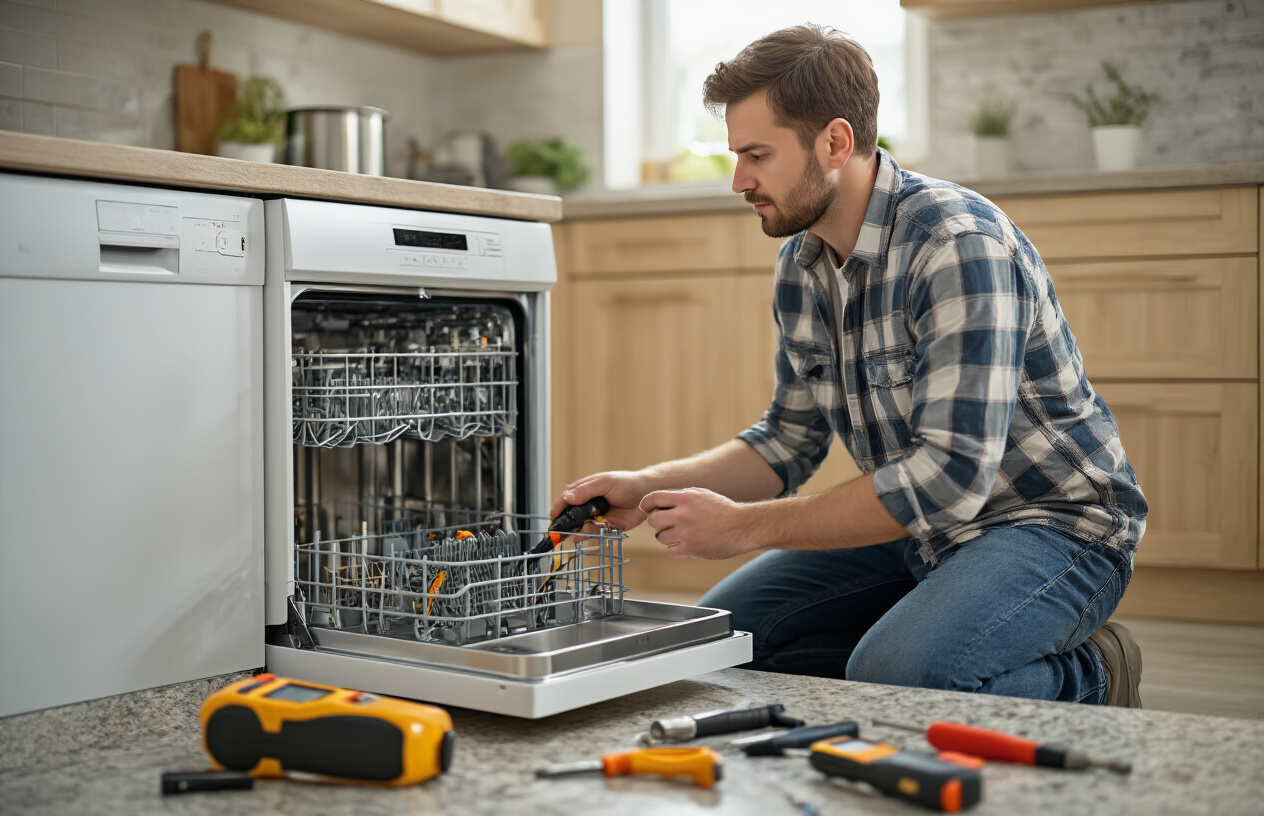
Start your dishwasher E1 error troubleshooting by examining the water supply system. Turn off the dishwasher completely and locate the water shut-off valve under your kitchen sink. Check if the valve is fully open – sometimes it gets accidentally turned during plumbing work or cleaning. The valve handle should be parallel to the water line for full flow.
Inspect the water inlet hose connecting your dishwasher to the main water supply. Look for kinks, bends, or pinched areas that could restrict water flow. Remove any visible debris or buildup around the connection points. If you notice mineral deposits or corrosion, clean them with a damp cloth and white vinegar solution.
Check your home’s water pressure by running the kitchen faucet at full blast. Low water pressure throughout your house can trigger the dishwasher E1 error. Most dishwashers need at least 20 PSI to operate properly. If water barely trickles from the faucet, contact your water utility company or a plumber.
Clogged filters are a common culprit behind dishwasher E1 error issues. Remove the bottom dish rack to access the cylindrical filter assembly at the dishwasher’s base. Twist counterclockwise to remove the filter – some models have multiple filter components that separate.
Rinse the filters under hot running water while scrubbing gently with an old toothbrush. Remove stuck food particles, grease buildup, and soap scum. For stubborn deposits, soak filters in warm water mixed with baking soda for 15 minutes before scrubbing.
The spray arms also need regular cleaning to prevent water supply errors. Pop out the lower spray arm by lifting it straight up, and remove the upper arm by unscrewing its center cap. Check each hole for clogs using a thin wire or toothpick. Rinse thoroughly under hot water, shaking to dislodge trapped debris.
Door seal problems can trigger false error readings, making your dishwasher think there’s a water supply issue when it’s actually a leak detection problem. Run your finger along the rubber door gasket, feeling for tears, cracks, or hardened sections. Look for food particles or soap buildup that might prevent proper sealing.
Clean the door seals with warm soapy water and a soft cloth. Pay special attention to the bottom seal where debris tends to collect. Check that the door closes firmly and the latch engages completely – a loose door can confuse the control system.
Test the door latch mechanism by opening and closing the door several times. The latch should click securely into place without excessive force. If the door feels loose or doesn’t align properly, the latch assembly might need adjustment or replacement.
Sometimes the dishwasher E1 error persists due to a temporary electronic glitch rather than an actual mechanical problem. Perform a hard reset by unplugging the dishwasher from its power source for at least 5 minutes. If your unit is hardwired, flip the circuit breaker instead.
After reconnecting power, try running a short wash cycle to see if the error clears. Many dishwashers also have specific button combinations for factory resets – check your owner’s manual for the exact sequence. Common reset procedures involve holding the start button for 3-5 seconds or pressing multiple buttons simultaneously.
Clear any stored error codes by pressing and holding the control panel buttons as specified in your model’s manual. This reset often resolves false error readings caused by power fluctuations or temporary sensor malfunctions.
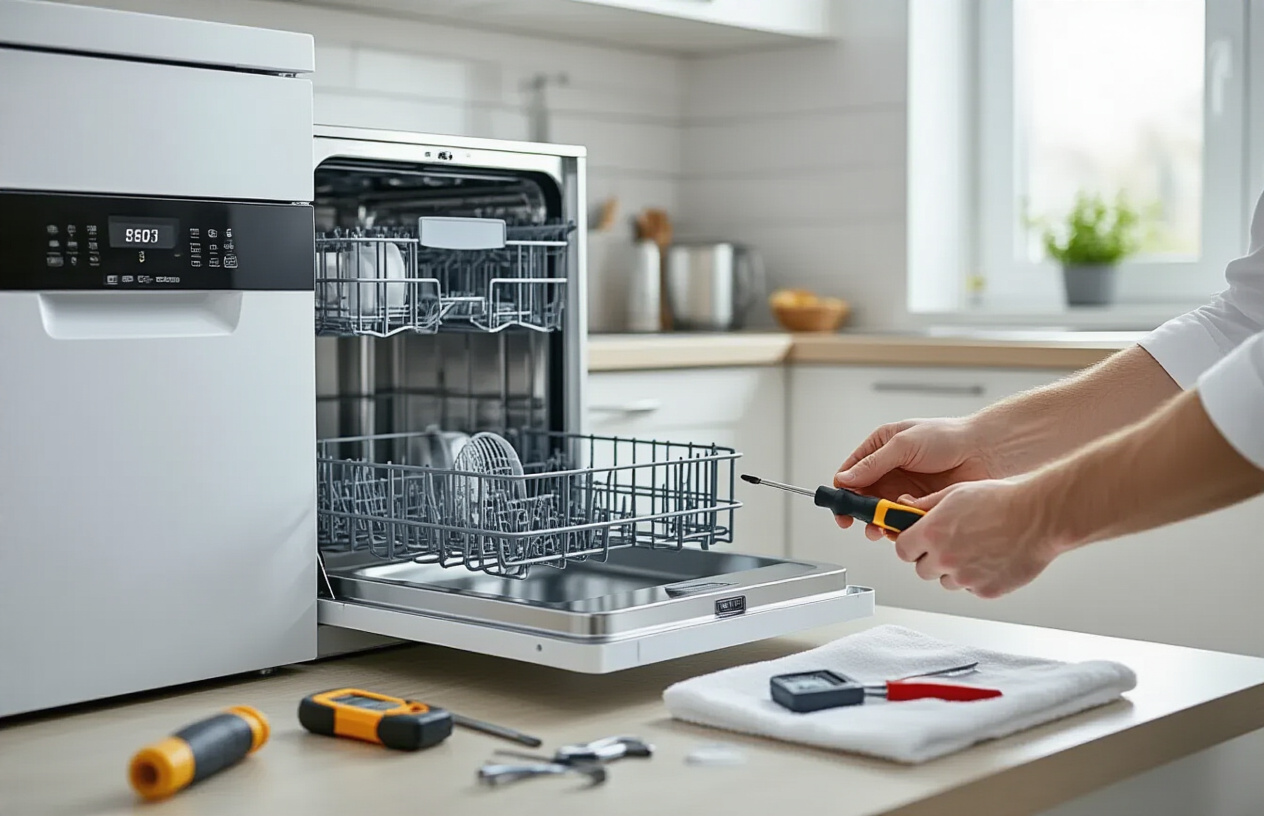
When your dishwasher’s water inlet valve fails, it directly triggers the E1 error by disrupting proper water flow. Start by turning off power and water supply to your dishwasher. Remove the bottom front panel to access the valve, typically located behind the kick plate on the left side.
Check for visible damage like cracks, mineral buildup, or loose connections. The valve has two solenoids that control hot and cold water – test each with a multimeter for continuity. A reading of 500-1500 ohms indicates normal function, while infinite resistance means replacement is needed.
To replace the valve:
Cost Range: $50-$120 for parts, $150-$300 with professional installation
Poor drainage causes water backup, triggering dishwasher E1 error drain pump issues. Begin by checking your garbage disposal – run it with cold water for 30 seconds to clear any debris. Many dishwashers connect directly to disposals, so blockages here affect dishwasher drainage.
Next, inspect the drain hose connection under your sink. Look for kinks, clogs, or improper installation. The hose should have a high loop or connect to an air gap to prevent backflow.
For thorough cleaning:
If water pools at the bottom of your tub, the issue likely stems from drain system blockages rather than water supply problems.
Dishwasher sensors monitor water levels, temperature, and flow rates. When these fail, your dishwasher can’t properly detect operating conditions, leading to dishwasher E1 error float switch or pressure sensor malfunctions.
Float Switch Testing:
Located in the front corner of the tub, this switch prevents overfilling. Lift the dome-shaped float – it should move freely without sticking. Use a multimeter to test continuity when the float is up versus down. Replace if readings don’t change between positions.
Water Level Sensor:
This pressure sensor connects to a small tube near the sump area. Check for clogs in the sensing tube using compressed air. If the tube is clear but the sensor fails continuity testing, replacement is necessary.
Temperature Sensors:
These monitor water temperature for proper cleaning cycles. Test resistance values according to your model’s specifications – typically 10,000-15,000 ohms at room temperature.
Replacement Steps:
Sensor replacements typically cost $25-$75 per part and require basic electrical skills for proper installation.
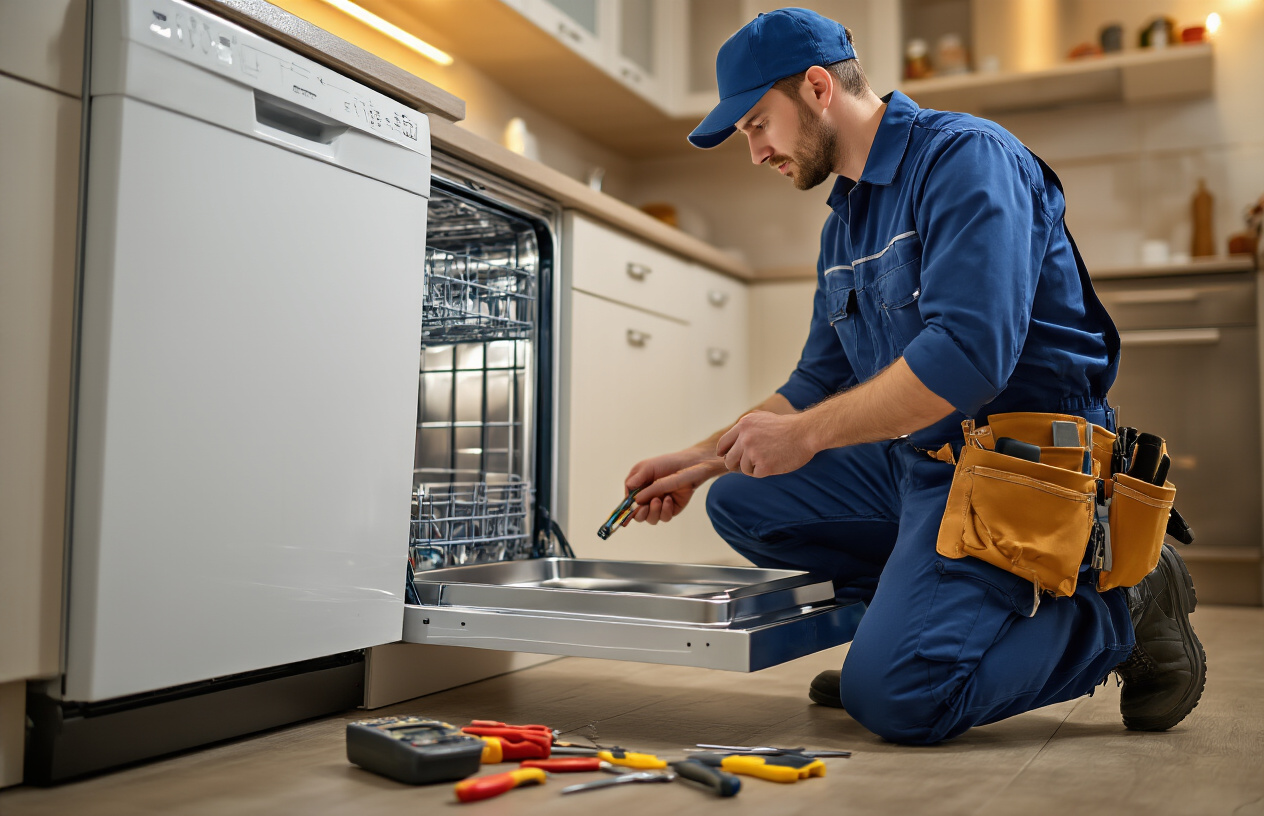
Complex E1 error situations require professional expertise, especially when multiple troubleshooting attempts fail. Call a certified technician if water continues leaking after replacing door seals, or if the dishwasher E1 error persists despite cleaning filters and checking hoses. Electrical issues with the control board or water level sensors also demand professional attention.
Signs that scream “professional help needed” include unusual noises during operation, visible corrosion on internal components, or recurring E1 errors every few wash cycles. If your dishwasher is less than two years old and showing these symptoms, professional diagnosis prevents voiding warranties through improper DIY repairs.
DIY dishwasher E1 error repairs typically cost $15-$75 for replacement parts like door gaskets, filters, or inlet hoses. Professional repairs range from $150-$400 depending on the root cause and required components.
| Repair Type | DIY Cost | Professional Cost | Time Investment |
|---|---|---|---|
| Door gasket replacement | $25-$50 | $180-$250 | 2-3 hours |
| Water inlet valve | $30-$60 | $200-$300 | 1-2 hours |
| Control board issues | $75-$150 | $300-$450 | 4-6 hours |
| Drain pump replacement | $40-$80 | $250-$350 | 3-4 hours |
Factor in your skill level and available time. Professional repairs include labor warranties and proper diagnosis, while DIY attempts might lead to additional problems if done incorrectly.
Manufacturer warranties typically become void when unauthorized repairs are performed. Most dishwasher warranties explicitly state that DIY repairs, especially those involving electrical components or water systems, nullify coverage.
Before attempting any dishwasher E1 error troubleshooting beyond basic cleaning, check your warranty status. Extended warranties from retailers often have similar restrictions. Document any professional repairs with receipts and service reports to maintain warranty protection.
Some manufacturers allow basic maintenance like filter cleaning without voiding warranties, but replacing seals, valves, or electrical components requires authorized service.
Start with manufacturer-authorized service centers for warranty-covered repairs. These technicians receive specific training for your dishwasher brand and have access to genuine replacement parts.
Local appliance repair companies often provide faster service and competitive pricing. Verify licenses, insurance coverage, and Better Business Bureau ratings before scheduling. Ask about experience with dishwasher E1 error repair specifically, as some technicians specialize in certain error codes.
Online platforms like Angie’s List, HomeAdvisor, or manufacturer websites help locate certified professionals. Request quotes from multiple services to compare dishwasher E1 error repair costs and service timelines. Quality technicians provide detailed estimates explaining the problem and proposed solutions before starting work.
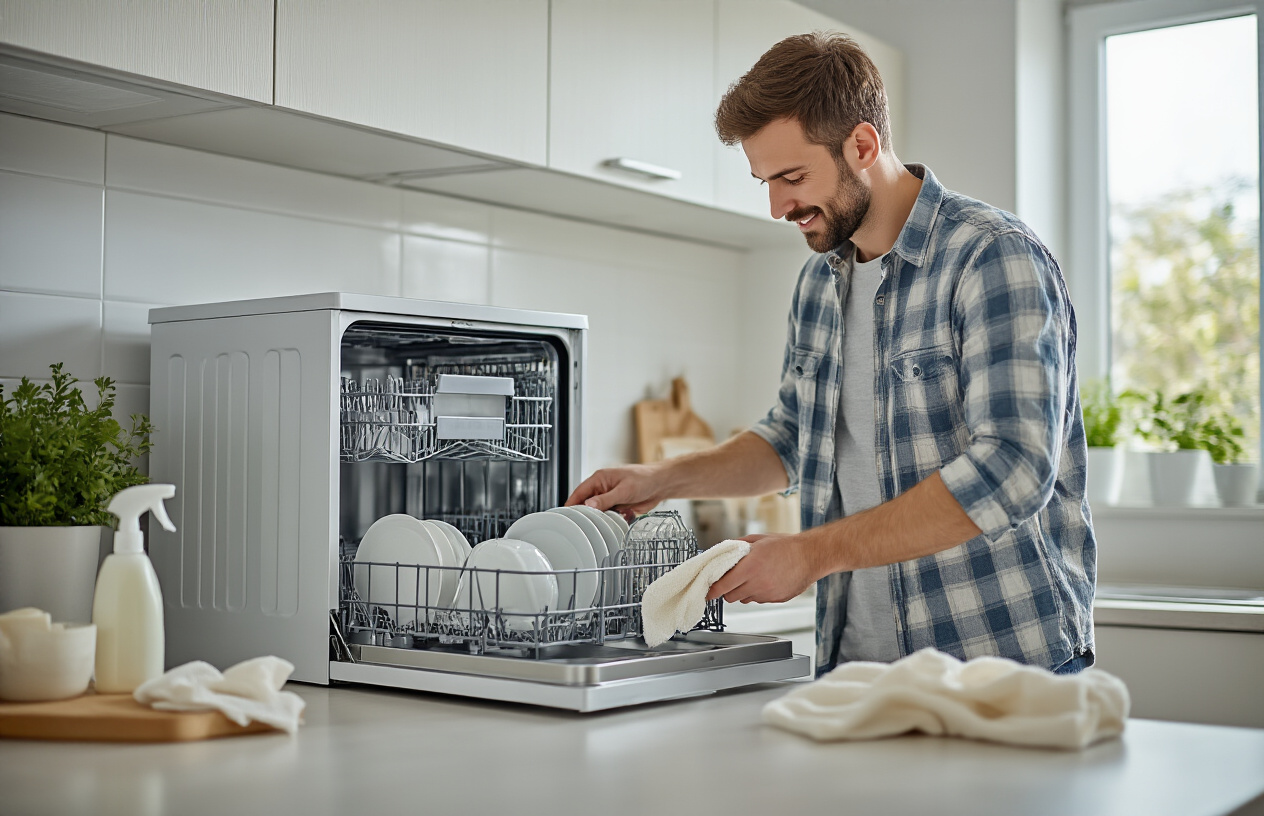
Creating a consistent maintenance routine is your best defense against future dishwasher E1 error troubleshooting headaches. Monthly filter cleaning should become as routine as changing your car’s oil. Remove and rinse the bottom dishwasher filter under hot water, scrubbing away grease buildup with an old toothbrush. Food particles and soap scum accumulation are primary culprits behind water flow restrictions that trigger E1 errors.
Check your dishwasher’s spray arms every two months by removing them and clearing any debris from the holes using a toothpick or thin wire. These rotating arms distribute water throughout your dishwasher, and blocked holes create uneven water pressure that confuses the system’s sensors.
Inspect door gaskets quarterly for tears or buildup. A compromised door seal can cause water leaks that activate the dishwasher’s safety systems, potentially triggering an E1 error. Run an empty cycle with dishwasher cleaner every three months to remove mineral deposits from internal components.
Annual professional inspections catch problems before they escalate. A technician can test water pressure, examine the drain pump, and verify that all sensors function correctly. This proactive approach costs less than emergency repairs and extends your appliance’s lifespan significantly.
Smart loading habits prevent most dishwasher water supply errors before they start. Scrape plates thoroughly but avoid pre-rinsing completely – modern dishwashers need some food residue to activate their sensors properly. Large food chunks, however, clog filters and create the perfect conditions for an E1 error.
Load dishes facing downward and inward toward spray arms. This positioning ensures proper water circulation and prevents food particles from settling in hard-to-reach corners. Avoid overcrowding racks, which blocks water flow and creates dead zones where cleaning suffers.
Place tall items like cutting boards and baking sheets along the sides rather than blocking the center spray arm. Nested dishes and stacked bowls trap water and debris, creating breeding grounds for buildup that eventually triggers error codes.
Secure lightweight items like plastic containers to prevent them from flipping over during wash cycles. Overturned containers collect dirty water and food particles that later redistribute throughout your dishwasher, potentially clogging filters and affecting water pressure sensors.
Hard water wreaks havoc on dishwashers, causing mineral buildup that restricts water flow and confuses sensors responsible for detecting proper water levels. Installing a whole-house water softener system addresses this problem at its source, preventing calcium and magnesium deposits from accumulating in your dishwasher’s internal components.
Consider adding a dedicated dishwasher water filter if a full softening system isn’t feasible. These compact units connect directly to your dishwasher’s water supply line and remove minerals that contribute to scale buildup. Regular filter cartridge replacement maintains optimal performance and prevents the gradual deterioration that leads to E1 errors.
Monitor your home’s water pressure regularly. Low water pressure often triggers dishwasher E1 error low water pressure situations, while excessive pressure can damage internal seals and sensors. Ideal water pressure ranges between 20-80 PSI for most dishwasher models.
Test your water’s hardness level annually using simple test strips available at hardware stores. Water hardness above 7 grains per gallon requires intervention to prevent long-term damage. Adjust your dishwasher’s rinse aid dispenser settings based on water hardness – harder water needs more rinse aid to prevent spotting and mineral deposits that contribute to sensor malfunctions.
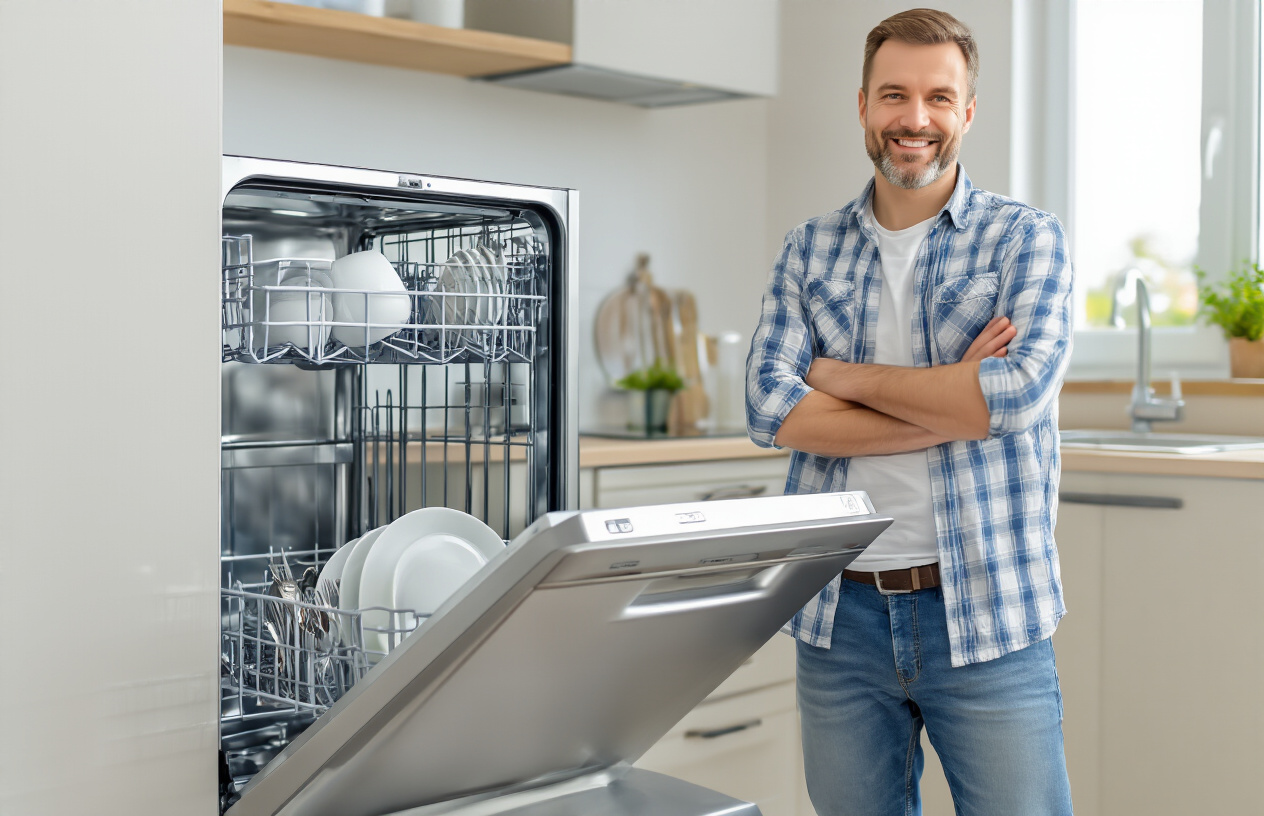
Dealing with an E1 error in your dishwasher doesn’t have to be overwhelming. Most E1 errors stem from water-related issues like blocked drains, faulty sensors, or pump problems that you can often tackle yourself with basic tools and a little patience. The troubleshooting steps we covered – from checking drain hoses to cleaning filters and testing door seals – will solve the majority of these frustrating error codes.
Remember that regular maintenance goes a long way in preventing E1 errors from popping up again. Clean your dishwasher’s filter monthly, run cleaning cycles, and keep an eye out for early warning signs like slow drainage or unusual noises. If the DIY approach doesn’t work or you’re not comfortable working with electrical components, calling a professional repair technician is always the smart choice. Your dishwasher will be back to running smoothly, and you’ll have the confidence to handle similar issues in the future.
